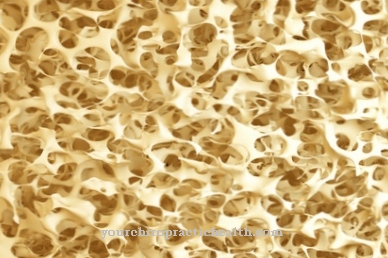As Endosymbiotic Theory an evolutionary biological hypothesis is known which attaches the development of higher life to the endosymbiosis of prokaryotes. The idea was first discussed at the end of the 19th century by the botanist Schimper. Many research results now speak for the theory.
What is the endosymbiotic theory?

The botanist Schimper first published the idea of the endosymbiotic theory in 1883, which should explain the origin of chloroplasts in his work. The Russian evolutionary biologist Konstantin Sergejewitsch Mereschkowski took up the endosymbiont theory again at the beginning of the 20th century. However, the theory did not become known until 1967 when it was picked up by Lynn Margulis.
In a simplified summary, the theory says that unicellular organisms were taken in by other unicellular organisms in the course of evolution. This uptake is said to have enabled the development of cell components of higher living beings. In this way, according to supporters of the theory, more and more complex life has arisen in the course of evolution.
So originally human cell components go back to protozoa. According to the theory, eukaryotes only emerged when prokaryotic precursor organisms entered into symbioses. In particular, chemotrophic and phototrophic bacteria are said to have been absorbed by other prokaryotic cells of the archaea in an act of phagocytosis.
Instead of digesting them, the prokaryotic cells kept them inside, where they became endosymbionts. These endosymbionts are said to have developed into cell organelles in host cells. The host cell and the organelles in it correspond to the eukaryotes. The cell organelles of the mitochondria and plastids still bear these characteristics today.
Since eukaryotes also exist without these organelles described, these components must either have been phased out or the theory does not apply.
Function & task
The endosymbiotic theory names the development of mitochondria and plastids in prokaryotic organisms. The unicellular organisms are said to have entered into an endosymbiosis with other cells and continued to live in the host cell. To this day, science sees amoeboid protozoa taking up cyanobacteria that continue to live in them. Observations like these seem to support the endosymbiotic theory.
In the course of evolution, according to the endosymbiotic theory, two organisms should have become mutually dependent, so that neither partner could survive without the other. The resulting endosymbiosis is said to have caused the organelles to lose parts of the genetic material that is no longer needed. The individual protein complexes in the organelles are said to have been composed partly of nucleus-coded and partly of mitochondrially-coded units.
According to genomic analyzes, the plastids are derived from cyanobacteria, while mitochondria are associated with aerobic proteobacteria. Science refers to the endosymbiosis between eukaryotes and prokaryotes as primary endosymbiosis. If cell organelles have arisen through the ingestion of a eukaryote with a previously experienced primary endosymbiosis event, we are talking about secondary endosymbiosis.
Primary plastids lie in two envelope membranes, which, according to the theory, correspond to the membranes of the cyanobacterium that has been absorbed. Three types of primary plastids and thus three lines of autotrophic organisms are said to have developed in this way. Single-cell algae of the Glaucocystaceae, for example, contain plastids of the cyanobacterium, as do red algae. Green algae and higher plants contain the most developed plastids, the chloroplasts. Secondary plastids have three or four covering membranes. Secondary endosymbioses between green algae and eukaryotes are now known, so that Euglenozoa and Chlorarachniophyta could have absorbed the primary endosymbionts independently of one another.
Illnesses & ailments
If the endosymbiotic theory is correct, as the current state of research suggests, all complexes of plant, animal and thus also human cells have their origin in a fusion of prokaryotes. Man would have prokaryotes to thank for life itself.
However, prokaryotes are also responsible for numerous diseases in contact with humans. In this context, reference should be made, for example, to the disease value of the Proteobacteria, which are particularly relevant in the endosymbiont theory. Many bacteria from this department are considered to be pathogens. This applies, for example, to Helicobacter pylori, a rod-shaped bacterium that colonizes the human stomach. With a prevalence of 50 percent, Helicobacter pylori infection is often one of the most common chronic bacterial infections worldwide. More than 30 million people are infected with the bacterium, but only between ten and 20 percent of all infected people develop symptoms.
The main symptoms are peptic ulcers, which can affect the stomach or duodenum. Taken as a whole, infections with the bacterium are held responsible for a whole range of gastric diseases, especially for those diseases that manifest themselves in increased secretion of gastric acid. In addition to the ulcers of the stomach and duodenum, the bacterium can therefore probably also be involved in type B gastritis.
The examination for a bacterial infection with the proteobacterium is now part of the standardized diagnosis of gastric diseases. Apart from the diseases mentioned, a chronic infection with the bacterium is now classified as a risk factor for gastric cancer. The same is true for MALT lymphoma.
There also appears to be a link between infection and diseases such as idiopathic chronic urticaria (hives), chronic immune thrombocytopenia, iron deficiency anemia and Parkinson's disease.
The Helicobacter pylori was only discussed here as an example. Numerous other prokaryotes are associated with disease value and are considered pathogens for humans, animals and plants.












.jpg)



.jpg)










.jpg)
